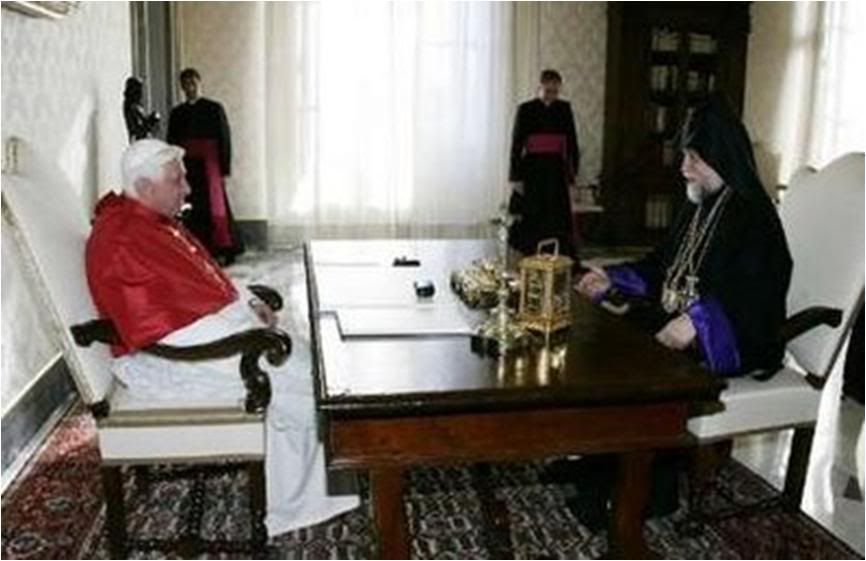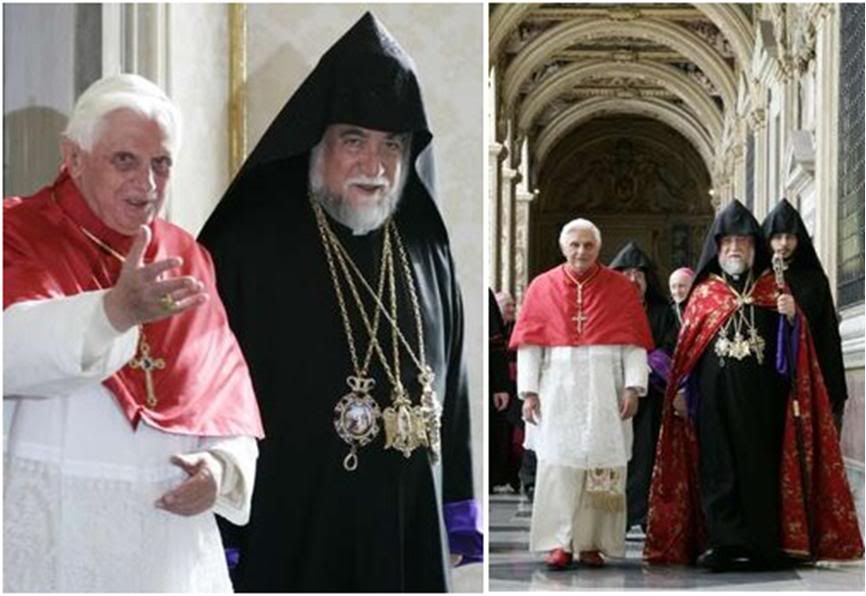 THE POPE MEETS
THE POPE MEETS
ARMENIAN 'CATHOLICOS'

Benedict XVI met with His Holiness Aram I, the Lebanese-born Catholicos of Cilicia of the Armenians, at the Vatican this morning, after which they both presided at an ecumenical celebration held in the Redemptoris Mater Chapel of the Apostolic Palace.
A delegation from the Catholicosate of Cilicia of the Armenians also participated in the event.
Born Pedros Keshishian in Beirut, Lebanon in 1947, the man who would become Aram I was ordained priest in 1968, and was consecrated bishop in Antelias on 22 August 1980.
From 1980 to 1995 he was Primate of Lebanon at the head of the Armenian Prelacy of Lebanon, part of the Catholicosate of the Great House of Cilicia, a Holy See of the Armenian Apostolic Church.
In 1991 he became moderator of the Central Committee of the World Council of Churches and also serves on the Middle East Council of Churches.


Here is the text of the English address delivered by the Holy Father after the ecumenical service:
ADDRESS TO HIS HOLINESS ARAM II,
CATHOLICOS OF ARMENIA
Your Holiness,
With heartfelt affection in the Lord, I greet you and the distinguished members of your delegation on the occasion of your visit to the Church of Rome.
Our meeting today stands in continuity with the visit which you made to my beloved predecessor Pope John Paul II in January 1997, and with the many other contacts and mutual visits which, by God’s grace, have led in recent years to closer relations between the Catholic Church and the Armenian Apostolic Church.
In this year of Saint Paul, you will visit the tomb of the Apostle of the Nations and pray with the monastic community at the basilica erected to his memory. In that prayer, you will be united to the great host of Armenian saints and martyrs, teachers and theologians, whose legacy of learning, holiness and missionary achievements are part of the patrimony of the whole Church.
We think of Saint Nerses Shnorkhali and Saint Nerses of Lambon who, as Bishop of Tarsus, was known as "the second Paul of Tarsus".
That testimony culminated in the twentieth century, which proved a time of unspeakable suffering for your people. The faith and devotion of the Armenian people have been constantly sustained by the memory of the many martyrs who have borne witness to the Gospel down the centuries.
May the grace of that witness continue to shape the culture of your nation and inspire in Christ’s followers an ever greater trust in the saving and life-giving power of the Cross.
The See of Cilicia has long been involved in encouraging positive ecumenical contacts between the Churches. Indeed, the dialogue between the Oriental Orthodox Churches and the Catholic Church has benefited significantly from the presence of its Armenian delegates.
We must be hopeful that this dialogue will continue to move forward, since it promises to clarify theological issues which have divided us in the past but now appear open to greater consensus.
I am confident that the current work of the International Commission – devoted to the theme: "The Nature, Constitution and Mission of the Church" – will enable many of the specific issues of our theological dialogue to find their proper context and resolution.
Surely the growth in understanding, respect and cooperation which has emerged from ecumenical dialogue promises much for the proclamation of the Gospel in our time.
Throughout the world Armenians live side by side with the faithful of the Catholic Church. An increased understanding and appreciation of the apostolic tradition which we share will contribute to an ever more effective common witness to the spiritual and moral values without which a truly just and humane social order cannot exist.
For this reason, I trust that new and practical means will be found to give expression to the common declarations we have already signed.
Your Holiness, I cannot fail to assure you of my daily prayers and deep concern for the people of Lebanon and the Middle East. How can we not be grieved by the tensions and conflicts which continue to frustrate all efforts to foster reconciliation and peace at every level of civil and political life in the region?
Most recently we have all been saddened by the escalation of persecution and violence against Christians in parts of the Middle East and elsewhere. Only when the countries involved can determine their own destiny, and the various ethnic groups and religious communities accept and respect each other fully, will peace be built on the solid foundations of solidarity, justice and respect for the legitimate rights of individuals and peoples.
With these sentiments and with affection in the Lord, I thank Your Holiness for your visit, and I express my hope that these days spent in Rome will be a source of many graces for you and for all those entrusted to your pastoral care.
Upon you and to all the faithful of the Armenian Apostolic Church I invoke an abundance of joy and peace in the Lord.
I know very little about the Eastern Churches of the Catholic world, and perhaps this background would also be helpful to others on the Forum:
The Armenian Apostolic Church is one of the oldest branches of the Christian faith. The earliest authentic accounts of the introduction of Christianity into Armenia date from the apostolic work of St. Gregory the Illuminator, who, in 303, converted King Tiridates III and members of his court.
Christianity was strengthened in Armenia by the translation of the Bible into the Armenian language by the Armenian monk and scholar St. Mesrob. Following the ecclesiastical controversy concerning the twofold nature of Christ, the Armenian Christians refused to accept the decisions of the Council of Chalcedon and formed a separate Church, sometimes referred to as the Gregorian Church.
In 1439 a union with the Roman Catholic church was accepted by some members of the Armenian Church. This was later repudiated, but a group of Armenian Catholics accept papal supremacy and the authority of the Catholic Armenian patriarchate of Sis or Cilicia (in Beirut, Lebanon), which was set up in 1742 [this is distinct from the Orthodox Catholicosate of Cilicia headed by Aram I]. They use an Armenian rite.
The remaining larger portion of the Orthodox Armenian church is headed by its Catholicos, who resides at Etchmiadzin, a monastery near Yerevan, the capital of Armenia.
He has nominal authority over the Armenian patriarchs of Jerusalem and Constantinople (Istanbul). The monastery has been the ecclesiastical metropolis of the Armenian nation since the 4th century; it is said to be the oldest monastic foundation in the Christian world.
The Armenian patriarchate was transferred from Armenia to Cilicia in 1058. Although the See at Echmiadzin was restored in 1441, the Cilician catholicosate continued in existence, and continues to exist to the present day. Both Etchmiadzin and Cilicia are considered Orthodox Churches.
Today the see is located in Antelias, Lebanon. His Holiness, the Catholicos of Armenia and All Armenians claims sovereignty over the Catholicos of Cilicia, though the latter operates independently.
Here's an earlier report from Vatican Radio about the Armenian patriarch's visit:
The significance of
Aram I's visit
Translated from
the Italian service of

Aram I, Catholicos of Cilicia of the Armenians, arrived in Rome Sunday for a five-day visit, which takes place after many similar visits to Rome by him and by the Catholicos of Etchmiadzin, the main seat of the Armenian Apostolic Church in the Armenian capital of Yerevan (visited by Cardinal Tarcisio Bertone earlier this year).
The program for His Aram's visit provides for two meetings with Pope Benedict XVI. The first is at a Monday morning audience in the Apostolic Place, and the second at the General Audience on Wednesday.
Before meeting the Pope Monday, Aram was to pray at the tomb of John Paul II and then before the statue of St. Gregory the Illuminator found in one of the external niches of the Basilica.
Monday afternoon, he will be at the Basilica of St. Paul outside the Walls where he will celebrate a brief liturgy.
On Tuesday morning, he will deliver a lectio magistralis at the Pontifical Urbanian University on the subject of "Christians in the Middle East".
On Tuesday afternoon, he will participate in Vespers at the Basilica of St. Bartholomew on the Isola Tiberina, at the memorial to the martyrs of the 20th century, and then proceed to a prayer meeting in Santa Maria in Trastevere.
Also on the program are separate meetings with Cardinal Water Kasper, president of the Pontifical Council for Promoting Christian Unity, and the officials of the dicastery's Oriental section; Cardinal Secretary of State Tarcisio Bertone; and Cardinal Jean Louis Tauran, president of the Pontifical Council for Inter-Religious Dialog.
Aram I came to Rome in January 1997 to meet John Paul II. It is significant to remember that the Armenian Apostolic Church is now divided into two 'Catholicosates' - those of Etchmiadzin (Yerevan) and Cilicia (Beirut).
Philippa Hitchen interviewed Cardinal Kasper on the significance of Aram I's visit:
CARDINAL KASPER: It is more than just a courtesy visit, because the Armenian Church of Cilicia is part of the family of Oriental Orthodox Churches and we are in dialog with them. So the visit has an ecumenical significance.
In the second place, Aram I is a highly respected figure in the context of ecumenism. And in the third place, we can discuss with him the situation in Lebanon which was once a Christian nation but where Christians are no longer in the majority.
However, the churches, particularly the Church leaders, have great political importance in Lebanon, and are important in any dialog for peace in the region.
The Catholicos is also here to venerate the martyrs of the so-called Armenian genocide under the Ottoman Turks at the start of the 20th century. What is the position of the Holy See about this tragic but controversial event?
It is certainly a wound in the conscience and heart of all Armenians, and the position of the Holy See was expressed by John Paul II when he visited Armenia. He prayed at the memorial for the victims of genocide, and he used the term, even if Turkey has always objected strongly to it.
But it is not a question of what term is used. It is a fact that there were several hundred thousand victims, and so this is a memory that needs to heal.
I don't know that the Holy See can do anything to improve relations between Armenia and Turkey, but certainly, this is one of those factors affecting peace in the Middle East. However, the Catholic Church must be, above all, on the side of the victims - and that is the principle that determines how we act.
[Pope Benedict did not use the term 'genocide' this morning in his address to Aram I - see text above - when he referred to the 'unspeakable suffering' that the Armenian people had undergone in the last century.]
NB: I cannot explain why ZENIT has come out with the Italian translation of Aram I's prepared remarks to the Pope this morning but has not posted the English original in its English service! I heard part of Aram's speech on Vatican Radio - he speaks
English beautifully!
[Modificato da TERESA BENEDETTA 26/11/2008 02:54]